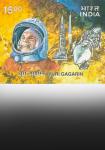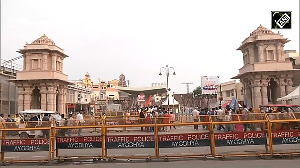Even their offices reflect their attitudes. ICICI Bank's headquarters in suburban Mumbai is a huge, imposing edifice in glass and granite. HDFC Bank's office in central Mumbai is comparatively smaller and more sedately furnished.
The two banks have carried forward their style statement in their approach to business. ICICI Bank thinks big, is all for growth and hungry for marketshare.
HDFC Bank is more conservative and cautious, grows at a measured pace, without taking any undue risks.
ICICI Bank's assets in the retail space stand at Rs 56,000 crore (Rs 560 billion). In comparison, the tally for HDFC Bank is Rs 18,000 crore (Rs 180 billion). ICICI Bank also leads HDFC Bank in almost every segment they are present in. But that's just the current update.
The DNA of the strategy
ICICI Bank began its retail banking venture in mid-1999. By January 2000, it had moved on to introducing home loans, car loans, personal loans and credit cards.
 Realising the need for a bigger retail deposit base, the bank started building a branch and an ATM network. The acquisition of Bank of Madura in March 2001 added 263 branches, many of them in cities where ICICI Bank did not have a presence.
Realising the need for a bigger retail deposit base, the bank started building a branch and an ATM network. The acquisition of Bank of Madura in March 2001 added 263 branches, many of them in cities where ICICI Bank did not have a presence.
The merger of the erstwhile financial institution ICICI Limited with the bank in April 2002, gave it a ready-made corporate clientele. The flip side was that ICICI Bank had Rs 10,000 crore (Rs 100 billion) of restructured assets for which it had to make provisions.
On the other hand, HDFC Bank kick started its operations in 1995 with a focus on corporate banking, targeting the top-end of the market. Reminisces Paresh Sukthankar, head, credit and market risk, HDFC Bank, "Although the asset yields may have been lower, we were able to cross-sell products so that the overall returns were better. We may have grown slower than our peers, but the risks were lower."
HDFC Bank ventured into retail lending in 1998, a year before ICICI Bank. But in products like credit cards, it was slow to get off the mark. For instance, its credit cards were launched only two years ago.
By then ICICI Bank had been present in the credit card business for nearly three years. Says Sukthankar, "We believe that a sales cycle is not completed till the asset comes back to us. So we were not aggressive in those products where we perceived the risks were higher."
 However, HDFC Bank was handicapped because it could not sell home loans (because its parent HDFC was in the business), though it has been originating them in the past one-and-a-half years. For ICICI Bank, home loans are 46 per cent of its retail assets.
However, HDFC Bank was handicapped because it could not sell home loans (because its parent HDFC was in the business), though it has been originating them in the past one-and-a-half years. For ICICI Bank, home loans are 46 per cent of its retail assets.
A banking consultant observes that ICICI Bank is far more aggressive. Though ICICI executives do not admit it, industry sources observe that ICICI's pricing has been far more competitive, which probably brought it more customers.
According to some industry experts, growth for ICICI Bank may have come at the cost of quality. ICICI Bank denies this.
Says Kalpana Morparia, deputy managing director, ICICI Bank, "If your screening is not tight, it will show up in the very first year of the loan. Our provisioning is very strict, so any defaults would show up in the non-performing loans (NPLs). Our home loan NPLs are just 0.25 per cent, while for car loans they are 0.45 per cent."
Calling the customer
Both players targeted the same customer -- the upper-middle class. The marketing channels used by both, including direct sales agents (DSAs), were the same.
Yet, there was a difference. While ICICI settled for nothing less than film star Amitabh Bachchan as an ambassador, HDFC Bank chose to rely on the trusted lineage of its housing finance parent, Housing Development Finance Corporation (HDFC).
Says Sukthankar, "While HDFC was no doubt a great brand, it was a single-product brand. Hence, it was a challenge to make it work with other products."
In the past two years, the bank has spent less than Rs 100 crore (Rs 1 billion) on advertising and publicity (In comparison, ICICI has spent Rs 185 crore).
HDFC Bank says that its spends have always focused on other channels such as direct sales and phone banking rather than mainstream advertising. Explains Neeraj Swaroop, country head, retail banking, "It made sense to get the direct communication right rather than focus on the masses. Meeting the customer face-to-face is important."
Is the brand visible enough? Swaroop acknowledges that the ICICI brand does have greater visibility, though he says that HDFC Bank is well-known even in smaller towns.
However, he does admit the need to push the brand and HDFC Bank will unveil a new campaign next month. True to its style, however, the spend on publicity this year will be upped by just 25-30 per cent.
Better pick-up
The numbers tell the story. ICICI Bank's retail deposits are nudging Rs 60,000 crore (Rs 600 billion) and in FY05, it grew its deposits by 47 per cent compared with the industry deposit growth of 14 per cent.
HDFC Bank's retail deposits are about Rs 23,000 crore (Rs 230 billion). Even in home loans, ICICI Bank commands 30 per cent of the market, having eaten into housing finance pioneer, HDFC's share.
Says Morparia, "The convenience proposition together with the geographical reach has paid off. We rolled out ATMs far ahead of the others and were able to cross-sell our products."
|
Share of the wallet | ||
|
Mar-05 |
HDFC Bank |
ICICI Bank |
|
Branches |
467 |
565 |
|
ATMs |
1,147 |
2,000 |
|
Cities |
211 |
371 |
|
Retail assets (Rs crore) |
18,000 |
56,000 |
|
Deposits (Rs crore) |
38,000 |
99,800 |
|
Car loans (Rs crore) |
2,500 |
11,500 |
|
Credit cards (Mn) |
1.3 |
3 |
|
Retail customers (Mn) |
6.4 |
13.7 |
|
Cost of deposits (%) |
3.2 |
4.5 |
|
Net interest margin (%) |
3.2 |
2.4 |
|
Net NPLs (%) |
0.2 |
2 |
Even in the number of customers ICICI Bank leads by a distance (See table: Share of the wallet). Nearly 14 million customers bank with ICICI Bank, while the number for HDFC Bank is less than half (6.4 million).
ICICI Bank has issued 3 million credit cards -- that is more than twice the number of HDFC Bank's credit card users. However, industry observers point out that ICICI Bank's effective users for credit cards may not be high.
Nonetheless, they concede that even with a discounted customer base, the numbers will still be strong. Even in businesses like online trading where the risks are relatively low, ICICI Bank commands a two-thirds marketshare.
Says Morparia, "We are the largest distributors of mutual fund products and RBI Bonds."
'Tell all' street
The stock market has always valued HDFC Bank at a huge premium -- at the current price of Rs 585, HDFC Bank is valued at 3.5 times price to forward book (valuation based on estimated book value in FY 06 of Rs 165).
The multiple for ICICI Bank that quotes at Rs 415, is just 2.1 (estimated book value Rs 194). The reason: the impeccable quality of HDFC Bank's balance sheet.
With NPLs of less than 0.2 per cent, compared with 2 per cent for ICICI Bank, its books are definitely in far better shape.
HDFC Bank's operations are also more profitable -- its net interest margin at 3.2 per cent is way higher than that of ICICI Bank's 2.4 per cent. Also, it is able to access deposits at a lower cost. On an average, it pays an interest of 3.2 per cent while ICICI Bank shells out 4.5 per cent.
Says Morparia, "We understand why the market gives a lower valuation. It's because we have more NPLs and we have assets like Dabhol on our books. We had a legacy of high NPLs of 5 per cent."
Given its legacy, ICICI Bank has not done a bad job. Its net interest margin in FY05 at 2.4 per cent was an improvement from the 1.9 per cent that it posted in FY04.
Moreover, net NPLs at 2 per cent in FY05 were down from 2.9 per cent in the previous year. ICICI Bank's cost of deposits, too, has come down by 90 basis points to 4.5 per cent. Says an analyst, "Things are changing. In the past the markets rewarded you for profitability. Now they will reward you for both growth and profitability."
Poised for take off
Does sheer size tilt the balance in favour of ICICI Bank? Observes a consultant, "When you opt for a high growth strategy, it's not necessary that you're always doing the smart thing. Scale has to be built with profitability otherwise it is not a sustainable advantage."
Sukthankar says, "While size and growth are important, success is also measured by other attributes such as margins and asset quality. Size beyond a point becomes less important."
He adds, "If you are not in the top three, it becomes difficult to get visibility or economies of scale. We have grown fast enough and reached a threshold level at which we have economies of scale."
However, consultants believe that HDFC Bank could have leveraged its parent's customers far more effectively to cross-sell products and grow faster.
Says a banking consultant, "While HDFC Bank has about two years to get ready for the future, ICICI Bank probably has three years." Should HDFC Bank and its parent be merged, it could catapult them to a new league.
But round one of the banking sweepstakes has clearly gone to ICICI Bank.








 © 2025
© 2025